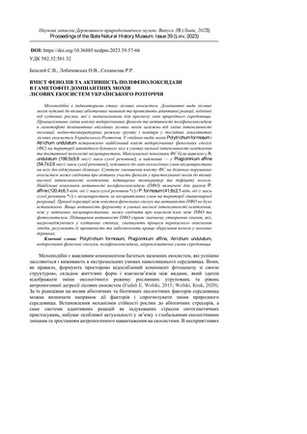Beshlei S.V., Lobachevska O.V., Sokhanchak R.R.
The content of phenols and activity of polyphenol oxidase in the hametophyte of dominant mosses in forest ecosystems of the Ukrainian Roztochia // Proc. of the State Nat. Hist. Mus. - Lviv, 2023. - 39. - P. 57-66 DOI: https://doi.org/10.36885/nzdpm.2023.39.57-66 Key words: Polytrichum formosum, Plagiomnium affine, Atrichum undulatum, water-soluble phenolic compounds, polyphenol oxidase, microclimatic environmental conditions Bryophytes are indicators of the state of forest ecosystems. Dominant species of forest mosses are sensitive to the influence of abiotic factors and demonstrate adaptive reactions different from vascular plants, which are decisive for the prediction of changes in the natural environment. We have analyzed the changes in the content of water-soluble phenols and the activity of polyphenol oxidase n the hametophyte of dominant epigean forest mosses depending on changes in the intensity of insolation, the water and temperature regime of soils and air in experimental localities of forest ecosystems of the Ukrainian Roztochia. The highest content of water-soluble phenolic compounds was found in the resistant mosses Polytrichum formosum and Atrichum undulatum on the territory of protected beech forest under conditions of low light intensity and sufficient humidity of local vegetation. The maximum indicators of the content of phenolic compounds were found in A. undulatum (199.5±9.8 μg/g of dry matter mass), and the lowest – in Plagiomnium affine (54.7±2.6 μg/g of dry matter mass) that is sensitive to changes in the ecological conditions of local vegetation in all studied areas. A significant decrease in the content of phenolic compounds in areas of disturbed ecosystems may indicate the active participation of phenols in the adaptation of mosses to the effects of high light intensity, elevated temperatures and moisture deficit. The highest indicators of polyphenol oxidase activity were determined in P. affine (120.4±6.1 relative units/g of dry matter mass*s) and P. formosum (41.8±2.1 relative units/g of dry matter mass*s) from local vegetation under unfavorable conditions on the territory of stationary recreation. A direct correlation between the content of phenolic compounds and the activity of polyphenol oxidase was not established. The higher activity of this enzyme under conditions of high light intensity than in shaded local plants may indicate a relationship between polyphenol oxidase and photosynthesis. An increase in the activity of polyphenol oxidase contributes to the significant formation of quinones, which, accumulating in cell walls, reduce the processes of lipid peroxidation, regulate their permeability and ensure better moisture storage in the moss turfs.
The content of phenols and activity of polyphenol oxidase in the hametophyte of dominant mosses in forest ecosystems of the Ukrainian Roztochia // Proc. of the State Nat. Hist. Mus. - Lviv, 2023. - 39. - P. 57-66 DOI: https://doi.org/10.36885/nzdpm.2023.39.57-66 Key words: Polytrichum formosum, Plagiomnium affine, Atrichum undulatum, water-soluble phenolic compounds, polyphenol oxidase, microclimatic environmental conditions Bryophytes are indicators of the state of forest ecosystems. Dominant species of forest mosses are sensitive to the influence of abiotic factors and demonstrate adaptive reactions different from vascular plants, which are decisive for the prediction of changes in the natural environment. We have analyzed the changes in the content of water-soluble phenols and the activity of polyphenol oxidase n the hametophyte of dominant epigean forest mosses depending on changes in the intensity of insolation, the water and temperature regime of soils and air in experimental localities of forest ecosystems of the Ukrainian Roztochia. The highest content of water-soluble phenolic compounds was found in the resistant mosses Polytrichum formosum and Atrichum undulatum on the territory of protected beech forest under conditions of low light intensity and sufficient humidity of local vegetation. The maximum indicators of the content of phenolic compounds were found in A. undulatum (199.5±9.8 μg/g of dry matter mass), and the lowest – in Plagiomnium affine (54.7±2.6 μg/g of dry matter mass) that is sensitive to changes in the ecological conditions of local vegetation in all studied areas. A significant decrease in the content of phenolic compounds in areas of disturbed ecosystems may indicate the active participation of phenols in the adaptation of mosses to the effects of high light intensity, elevated temperatures and moisture deficit. The highest indicators of polyphenol oxidase activity were determined in P. affine (120.4±6.1 relative units/g of dry matter mass*s) and P. formosum (41.8±2.1 relative units/g of dry matter mass*s) from local vegetation under unfavorable conditions on the territory of stationary recreation. A direct correlation between the content of phenolic compounds and the activity of polyphenol oxidase was not established. The higher activity of this enzyme under conditions of high light intensity than in shaded local plants may indicate a relationship between polyphenol oxidase and photosynthesis. An increase in the activity of polyphenol oxidase contributes to the significant formation of quinones, which, accumulating in cell walls, reduce the processes of lipid peroxidation, regulate their permeability and ensure better moisture storage in the moss turfs.
References
- Бешлей С.В., Лобачевська О.В., Соханьчак Р.Р. 2021. Сезонні зміни вмісту пластидних пігментів у гаметофіті домінантних мохів у лісових екосистемах Українського Розточчя. Наукові записки ДПМ. Вип. 37. С. 95–104.
- Бешлей С., Соханьчак Р., Лобачевська О., Карпінець Л. 2015. Вміст фенолів і активність поліфенолоксидази в гаметофіті мохів Ceratodon purpureus (Hedw.) Вrid. та Bryum argenteum Hedw. за умов росту на відвалі вугільної шахти “Надія”. Вісник Львівського університету. Серія біологічна. № 69. С. 256–264.
- Войцехівська О.В., Капустян А.В., Косик О.І. та ін. 2010. Фізіологія рослин: практикум. Луцьк : Терен. 420 с.
- Зайцев Г.Н. 1990. Математика в экспериментальной ботанике. M. : Наука. 296 с.
- Запрометов М.Н. 1993. Фенольные соединения: распространение, метаболизм и функции в растениях. M. : Наука. 272 с.
- Ипатов В.С., Тархова Т.Н.. 1982. Микроклимат моховых и лишайниковых синузий в сосняке зеленомошно-лишайниковом. Экология. № 4. С. 27.
- Карпінець Л., Лобачевска О., Баранов В. 2016. Вплив мохів на мікрокліматичні умови едафотопів породних відвалів і їхні адаптаційні реакції. Біологічні студії / Studia Biologica. T. 10 Вип. 3–4. С. 119–128. DOI: https://doi.org/10.30970/sbi.1003.494
- Кобилецька M., Бойко I., Кавулич Я., Терек O. 2013. Фенольні сполуки як компонентисаліцилат-індукованої адаптивної відповіді рослин пшениці на токсичну дію кадмію хлориду. Біологічні студії / Studia Biologica. T. 7. Вип. 2. С. 75–82. DOI: https://doi.org/10.30970/sbi.0702.283
- Кузьминa П.А., Бухарина И.Л. 2020. Биохимический состав листьев клена остролистного (Acer platanoides L.) в урбаносреде. Вестник Пермского университета. Вып. 1. С. 48–53. DOI: https://doi.org/10.17072/1994-9952-2020-1-48-53
- Шушняк В., Савка Г. 2009. Історія природоохоронних досліджень території Яворівського національного природного парку. Вісник Львівського університету. Серія географічна. Вип. 37. С. 285–291.
- Araji S., Grammer T.A., Gertzen R., Anderson S.D., Mikulic-Petkovsek M., Veberic R., Phu M.E, Solar A., Leslie C.A., Dandekar A.M., Escobar M.A. 2014. Novel roles for the polyphenol oxidase enzyme in secondary metabolism and the regulation of cell death in walnut. Plant Physiol. Vol. 63 No 3, pp. 1191–203.
- Boeckx T., Winters A. L., Webb K. J., Kingston-Smith A. H. 2015. Polyphenol oxidase in leaves: is there any significance to the chloroplastic localization? Journal of Experimental Botany. Vol. 66 No 12, pp. 3571–3579. DOI: https://doi.org/10.1093/jxb/erv141
- Bogdanović M., Ilić M., Živković S., Sabovljević A., Grubišić D., Sabovljević M. 2011. Comparative study on the effects of NaCl on selected moss and fern representatives. Australian Journal of Botany. Vol. 59 No 8, pp. 734–740. DOI: https://doi.org/10.1071/BT11059
- Cansev A., Guien U, Eris A. 2009. Cold-hardiness of olive (Olea еurораеа L.) cultivars in cold-acclimated and non-acclimated stages: seasonal alteration of anti oxidative enzymes and dehydrin-like proteins. J. of Ag. Sci. Vol. 147, pp. 51–61.
- Fudali E, Wolski G.J. 2015. Ecological Diversity of Bryophytes on Tree Trunks in Protected Forests (A Case Study from Central Poland). Herzogia. Vol. 28, pp. 87–103. DOI: https://doi.org/10.13158/heia.28.1.2015.87
- Glime J.M. 2006. Bryophytes and Herbivory. Cryptogamie, Bryologie, Vol. 27 No 1, pp. 191-203.
- Herms D.A., Mattson W.J. 1992. The dilemma of plants: to grow or defend. Quarterly review of biology. No 67, pp. 283-335.
- Klama H. Żarnowiec J. Jędrzejko K. 1999. Mszaki naziemne w strukturze zbiorowiskroślinnych rezerwatów przyrody Makroregionu Południowego Polski. Bielsko-Biała: Politechnika Łódzka Filia w Bielsku-Białej. DOI: https://doi.org/10.1046/j.1537-2995.1999.39399219278.x [In Polish]
- Larcher W. 2000. Temperature stress and survival ability of Mediterranean sclerophyllous plants. Plant Biosyst. Vol. 134, pp. 279-295.
- Liu B., Lei C., Shu T. et all. 2015. Effects of low-temperature stress on secondary metabolism in mosses exposed to simulated N deposition. Plant Ecology & Diversity. Vol. 8 No 3, pp. 415–426. DOI: https://doi.org/10.1080/17550874.2015.1010187
- Mölder A., Schmidt M., Schönfelder E., Engel F., Schulz F. 2015. Bryophytes as indicators of ancient woodlands in Schleswig-Holstein (Northern Germany). Ecological Indicators. Vol. 54, pp. 12–30.
- Ortega-Garcha F., Peragon J. 2009. The response or phenylalanine ammonia-lyase, polyphenol oxidase and phenols to cold stress in the olive tree (Olea europaea L. cv. Picual). J. Agr. and Food Chem. Vol. 89, pp. 1565–1573.
- Richter H., Lieberei R., von Schwartzenberg K. 2005. Identification and Characterisation of a Bryophyte Polyphenol Oxidase Encoding Gene from Physcomitrella patens. Plant Biol (Stuttg). Vol. 7 No 3, pp. 283–291. DOI: https://doi.org/10.1055/s-2005-837598
- Smolińska-Kondla D., Zych M., Ramos P., Wacławek S., Stebel A. 2022. Antioxidant potential of various extracts from 5 common European mosses and its correlation with phenolic compounds. Herba polonica. Vol. 68 No 2, pp. 54–68. DOI: https://doi.org/10.2478/hepo-2022-0014
- Tahvanainen T., Haraguchi A. 2013. Effect of pH on phenol oxidase activity on decaying Sphagnum mosses. European Journal of Soil Biology. Vol. 54, pp. 41–47. DOI: https://doi.org/10.1016/j.ejsobi.2012.10.005
- Thakur S., Kapila S. 2017. Seasonal changes in antioxidant enzymes, polyphenol oxidase enzyme, flavonoids and phenolic content in three leafy liverworts. Lindbergia. Vol. 40 No 5, pp. 39–44. DOI: https://doi.org/10.25227/linbg.01076
- Turunen M., Olsson J., Dallner G. 2004. Metabolism and function of coenzyme Q. Biochim. Biophys. Acta-Biomembr. No 1660, pp. 171–199.
- Wolski G.J., Sadowska B., Fol M., Podsędek A., Kajszczak D., Kobylińska A. 2021. Cytotoxicity, antimicrobial and antioxidant activities of mosses obtained from open habitats. PLoS ONE. P. 1–24. DOI: https://doi.org/10.1371/journal.pone.0257479
- Wolski G.J, Kruk A. 2020. Determination of plant communities based on bryophytes: The combined use of Kohonen artificial neural network and indicator species analysis. Ecol Indic. DOI: https://doi.org/10.1016/j.ecolind.2020.106160
- Zhang S. 2023. Recent Advances of Polyphenol Oxidases in Plants. Molecules. Vol. 28 No 5, pp. 2158. DOI: https://doi.org/10.3390/molecules28052158
- Zubel R., Danylkiv I., Rabyk I., Lobaczevs’ka O., Soroca M. 2015. Bryophyte sof the Roztocze region (Poland and Ukraine). Maria Curie–Sklodowska University. Lublin. S. 1-145.


